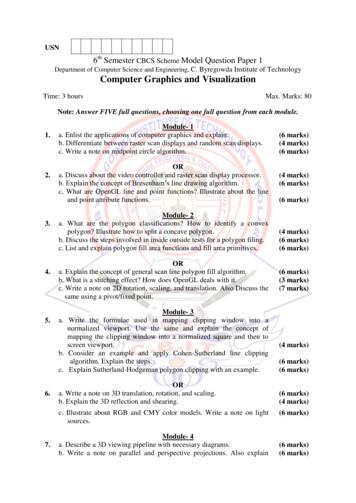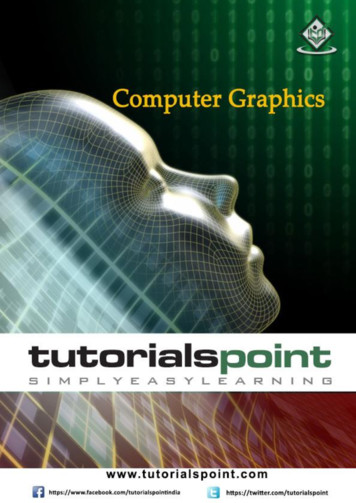Computer Graphics
Computer Graphics(601.457/657)Prof. Misha Kazhdanmisha@cs.jhu.edu
Outline Introduction Syllabus Coursework Miscellaneous
Introduction: What is CG? 2D image processing 3D object representation & manipulation Simulating physical processes & materials Animating any of the above
Introduction: What is CG? 2D image processing 3D object representation & manipulation Simulating physical processes & materials Animating any of the abovehttp://paulbakaus.com/
Introduction: What is CG? 2D image processing 3D object representation & manipulation Simulating physical processes & materials Animating any of the above“Incredibles 2” Disney / Pixar
Introduction: What is CG? 2D image processing 3D object representation & manipulation Simulating physical processes & materials Animating any of the aboveGringold et al. 2004
Introduction: What is CG? 2D image processing 3D object representation & manipulation Simulating physical processes & materials Animating any of the above (4D)Team Fortress 2: Meet the Heavy, Valve
Introduction: What is CG?“You know it when you see it ”http://www.creativecrash.com/tutorials/
Introduction: What is CG?“You know it when you see it maybe.”http://www.creativecrash.com/tutorials/
Introduction: Applications Entertainment Computer Aided Design Scientific Visualization Training & Education
Introduction: Applications Entertainment Computer Aided Design Scientific Visualization Training & Education“How to Train Your Dragon 3”DreamWorks“Control” Remedy
Introduction: Applications Entertainment Computer Aided Design Scientific Visualization Training & EducationCompletely virtual model built in 3D: Shorten the development period Shorten the learning curveBoeing 7E7
Introduction: Applications Entertainment Computer Aided Design Scientific Visualization Training & EducationNeutron Star CollisionCourtesy of David BockFlow VisualizationRoettger et al.Aspirin in RasMolCourtesy of Michael FriendlyThe Visible HumanCourtesy of NLM
Introduction: Applications Entertainment Computer Aided Design Scientific Visualization Training & EducationImage courtesy ofAgrawala et al.Microsoft Flight Simulator
Outline Introduction Syllabus Coursework Miscellaneous
Syllabus Image Processing (2D) Ray Tracing (3D) Rendering (3D) Modeling (3D) Animation (4D)
Syllabus Image Processing Quantization and DitheringSamplingFiltersWarping, Morphing, and Compositing
Syllabus Ray Tracing CamerasPrimitivesLightsSpatial Data StructuresReflection, Transparency and Refraction Rendering Coordinate Systems and Modeling TransformationsViewing transformationsShadingTexturesVisibilityOpenGL
Syllabus Modeling TrianglesSplinesSubdivision SurfacesProcedural ModelsPoint Based Models Animation Key-Framing Kinematics Dynamics
Outline Introduction Syllabus Coursework Miscellaneous
Coursework NB: Lots of work! Exams (30%) Programming assignments (60%) Class participation (10%)
Coursework NB: Lots of work! Exams (30%) (Probably) two exams Absolutely no excuses will be accepted for missing theexams. Not taking the exam at the scheduled time 0! Programming assignments (60%) Class participation (10%)
Coursework NB: Lots of work! Exams (30%) Programming assignments (60%) Image Processing (15%)Ray Tracing (15%)OpenGL Rendering (15%)Animation (15%) Class participation (10%)
Coursework NB: Lots of work! Exams (30%) Programming assignments (60%) Knowledge of C/C assumed!Must be turned in by 23:59 on due date5 late days (combined)Notify TA in your readme if you use a late day Class participation (10%)
Coursework: Collaboration Policy You must write your own code You must reference sources of ideas/code It’s okay to: Discuss ideas with other students Get ideas from books, web sites, etc. Get “support code” from books, web, etc.» REFERENCE IT It is not okay to: Share code with other students Copy code from other students Use ideas or code from other sources withoutattribution
Coursework NB: Lots of work! Exams (30%) Programming assignments (60%) Class participation (10%)Bottom line:If you don’t LOVE programming,don’t take this class!
Coursework NB: Lots of work! Exams (30%) Programming assignments (60%) Class participation (10%)
Outline Introduction Syllabus Coursework Miscellaneous
Miscellaneous Course web page: http://www.cs.jhu.edu/ misha/Fall21 Piazza page: http://piazza.com/jhu/fall2021/600457657» I will not look at posts unless explicitly notified! No required text book. Additional reading:» Computer Graphics: Principles and Practice in CFoley, van Dam, Feiner, and Hughes» Computer Graphics, C Version Hearn and Baker» OpenGL Programming Guide: The Official Guide to LearningOpenGL Neider, Davis, and Woo» Fundamentals of Computer Graphics Shirley Will not cover GPU programming (e.g. shaders)
Miscellaneous Office hours:» Misha’s (Professor): TBA» Tommy’s (TA): TBA» Aaron’s (CA): TBA» Keeping in touch: Email: cs457@cs.jhu.edu Note:» Do not send code snippets.» Do not ask us if your implementation is correct.
MiscellaneousAssignment 1: Image Processing Due September 25 @ 11:59 pm Even if you won't start working on the code until later,download it and try compiling ASAP to make sure thatthings are correctly set up on your system.
Computer Graphics: Principles and Practice in C. Foley, van Dam, Feiner, and Hughes » Computer Graphics, C Version. Hearn and Baker » OpenGL Programming Guide: The Official Guide to Learning OpenGL. Neider, Davis, and Woo » Fundamentals of Computer Graphics
Computer Graphics & Image Processing 2003 Neil A. Dodgson 2 7 Course books Computer Graphics: Principles & Practice Foley, van Dam, Feiner & Hughes,Addison-Wesley, 1990 zOlder version: Fundamentals of Interactive Computer Graphics Foley & van Dam, Addison-Wesley, 1982 Computer Graphics &
Introduction to Computer Graphics COMPSCI 464 Image credits: Pixar, Dreamworks, Ravi Ramamoorthi, . –Game design and development It is about –Learning the fundamentals of computer graphics –Implementing algorithms that are at the core of computer graphics . Fundamentals of Computer Graphics
Graphics API and Graphics Pipeline Efficient Rendering and Data transfer Event Driven Programming Graphics Hardware: Goal Very fast frame rate on scenes with lots of interesting visual complexity Pioneered by Silicon Graphics, picked up by graphics chips companies (Nvidia, 3dfx, S3, ATI,.). OpenGL library was designed for this .
Interactive graphics is useful in a. Training pilots b. Computer aided design c. Process control d. All of these 57. The origin of computer graphics was developed in a. 1950 b. 1960 c. 1970 d. 1990 58. The term business graphics came into use in late a. 1950 b. 1960 c. 1970 d. 1990 59. Computer graphics is used in many DTP software as a .
D. Salomon: Computer Graphics Geometric Modeling, Springer, 1999 A. Watt: 3D Computer Graphics. Addison-Wesley Publishing Company, Inc., 2000 Journals Computer Graphics Forum IEEE CG & Applications ACM Transactions on Graphics ACM Transaction
COMPUTER GRAPHICS & VISUALIZATION - 15CS62 Module -1 1. a. Enlist the applications of computer graphics and explain. (6 marks). i. Graphs and charts Display of simple data graphs was the early application of computer graphics plotted on a character printer. Data plotting one of the most common graphics applications
Graphics Courses Key course Image processing and computer graphics (modeling, rendering, simulation) Specialization courses Advanced computer graphics (global illumination) Simulation in computer graphics (deformable and rigid solids, fluids) Master project, lab course, Master thesis Simulation track, rendering track
Computer Graphics 6 Computer graphics is an art of drawing pictures on computer screens with the help of programming. It involves computations, creation, and manipulation of data. In other words, we can say that computer graphics is a rendering tool for the generation and manipulation of images. Cathode Ray Tube























